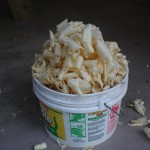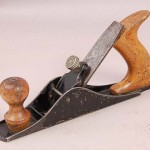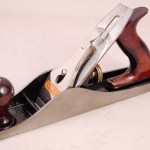My first plane and chisel sharpening work was freehand. I taught myself how to achieve a very sharp edge with a minimal amount of equipment. The techniques take a bit of concentration and practice, but are basic skills learned by many generations of craftsmen.
Yet, there was this lingering curiosity about the sharpening jigs found in the tool catalogs like this one or this one. Could they help me produce a better edge? They certainly look great but they’re way out of the price range I’m willing to pay to satisfy a curiosity.
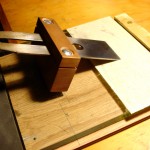 Then, I stumbled across Derek Cohen’s “10¢ sharpening system.” Well, not quite 10¢. I had a nice piece of cherry, but not suitable fasteners. I spent $1.40 and a couple of hours labor, a very acceptable price for an old galoot of Scottish heritage.
Then, I stumbled across Derek Cohen’s “10¢ sharpening system.” Well, not quite 10¢. I had a nice piece of cherry, but not suitable fasteners. I spent $1.40 and a couple of hours labor, a very acceptable price for an old galoot of Scottish heritage.
Curiosity satisfied. I’m not sure I get a “better” edge using a sharpening jig, but I can certainly produce an edge that is more repeatable. That is, each freehand sharpening result will be sharp, but might not be exactly xx degrees, whereas the jig always produces the same angular result. Using the jig removes the need to concentrate on maintaining a precise angle from stroke to stroke. The job is easier using the jig, but I enjoy knowing that I can be successful without it.
So, this entry is the place where I’ll keep the extension settings for the plane irons I currently have. Brent Beach’s extension calculator gave me these values.
Extension settings
These are for my particular jig which is 1 and 1/2 inches tall on the long side and just over 1/2 inch tall on the short side.
For Stanley and Sargent irons that are typically 0.08 inches thick, use the tall side and these extensions.
- 25° primary bevel – 3 and 12/32nds
- 28° micro bevel – 2 and 32/32nds
- 30° primary bevel – 2 and 24/32nds
- 33° micro bevel – 2 and 14/32nds
- 35° primary bevel – 2 and 8/32nds
- 38° micro bevel – 2 and 1/32nd
For spoke shaves with short blades about 0.06 inches thick, use the short side of the jig.
- 25° primary bevel – 1 and 11/32nds
- 28° micro bevel – 1 and 6/32nds
The rest of the system
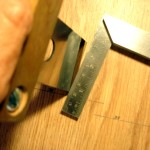 Many sharpening systems exist. The latest fashion uses diamond stones. Just before that was the Japanese water stones fad. Before that, and good enough for many generations, were oil stones, usually Arkansas stones. Somewhere along the way, some folks stumbled upon using sandpaper, the “Scary Sharp(tm)” method. There are proponents, and good sensible arguments for each approach. I shuddered at the cost of the water stones, and fell back upon a couple of two sided India stones I’ve had for decades. They’ll do in a pinch, but aren’t the optimal grits. So, I stopped by a glass store and bought an outcut of 1/2 inch plate glass. That and several grades of sandpaper from “the borg” rounds out the kit. I don’t go to the 1200 and 2000 grit levels suggested by some, but hone to 600 grit and then strop on a piece of card that’s prepped with white rouge. That’s plenty good enough to polish the back of an iron to a mirror finish and produce edges to hair shaving sharpness.
Many sharpening systems exist. The latest fashion uses diamond stones. Just before that was the Japanese water stones fad. Before that, and good enough for many generations, were oil stones, usually Arkansas stones. Somewhere along the way, some folks stumbled upon using sandpaper, the “Scary Sharp(tm)” method. There are proponents, and good sensible arguments for each approach. I shuddered at the cost of the water stones, and fell back upon a couple of two sided India stones I’ve had for decades. They’ll do in a pinch, but aren’t the optimal grits. So, I stopped by a glass store and bought an outcut of 1/2 inch plate glass. That and several grades of sandpaper from “the borg” rounds out the kit. I don’t go to the 1200 and 2000 grit levels suggested by some, but hone to 600 grit and then strop on a piece of card that’s prepped with white rouge. That’s plenty good enough to polish the back of an iron to a mirror finish and produce edges to hair shaving sharpness.
By the way, the first picture shows the jig in use sharpening the iron from a jack plane. It is working on 220 grit sandpaper that’s mounted on one end of my 1/2 inch piece of plate glass. That, in turn, sits atop a bench hook to keep it from sliding around.

